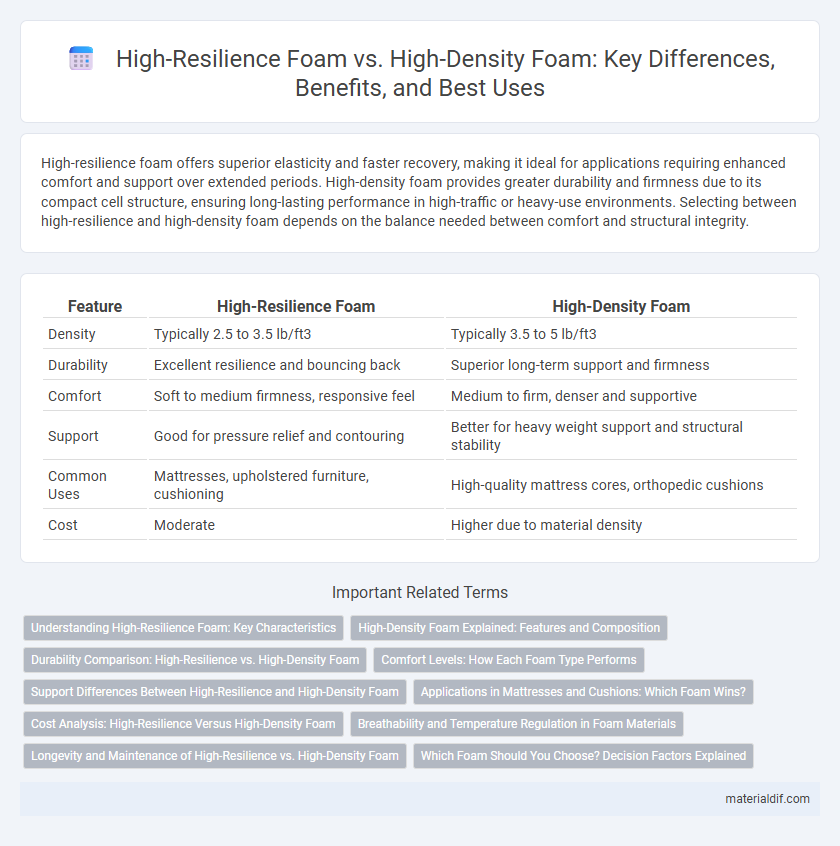High-resilience foam offers superior elasticity and faster recovery, making it ideal for applications requiring enhanced comfort and support over extended periods. High-density foam provides greater durability and firmness due to its compact cell structure, ensuring long-lasting performance in high-traffic or heavy-use environments. Selecting between high-resilience and high-density foam depends on the balance needed between comfort and structural integrity.
Table of Comparison
| Feature | High-Resilience Foam | High-Density Foam |
|---|---|---|
| Density | Typically 2.5 to 3.5 lb/ft3 | Typically 3.5 to 5 lb/ft3 |
| Durability | Excellent resilience and bouncing back | Superior long-term support and firmness |
| Comfort | Soft to medium firmness, responsive feel | Medium to firm, denser and supportive |
| Support | Good for pressure relief and contouring | Better for heavy weight support and structural stability |
| Common Uses | Mattresses, upholstered furniture, cushioning | High-quality mattress cores, orthopedic cushions |
| Cost | Moderate | Higher due to material density |
Understanding High-Resilience Foam: Key Characteristics
High-resilience foam features an open-cell structure that provides superior bounce, durability, and breathability, making it ideal for furniture and mattresses requiring responsive support. It typically has an indentation force deflection (IFD) rating ranging from 28 to 40, indicating a balance between softness and firmness. Compared to high-density foam, which emphasizes weight per cubic foot often above 4.5 lbs, high-resilience foam focuses on elasticity and comfort over sheer density.
High-Density Foam Explained: Features and Composition
High-density foam is characterized by its superior material composition, often containing more than 1.8 pounds per cubic foot of polyurethane, which provides exceptional durability and support. Its tightly packed cells create a firm structure that resists sagging and absorbs weight evenly, making it ideal for long-term use in mattresses and upholstery. Unlike high-resilience foam, which prioritizes bounce and elasticity, high-density foam emphasizes stability and longevity through its compact molecular makeup.
Durability Comparison: High-Resilience vs. High-Density Foam
High-resilience foam offers superior durability due to its ability to quickly regain shape and resist sagging, making it ideal for high-traffic applications, whereas high-density foam provides firm support but may compress over time under continuous pressure. The cellular structure of high-resilience foam promotes longevity by maintaining consistent firmness, while high-density foam's compact makeup delivers durability through its resistance to permanent deformation. Choosing between the two depends on application demands, with high-resilience foam excelling in dynamic environments and high-density foam sustaining prolonged static loads.
Comfort Levels: How Each Foam Type Performs
High-resilience foam offers superior comfort by providing excellent bounce and support, adapting quickly to body movements and reducing pressure points. High-density foam delivers firmer support and durability, maintaining its shape over time but may feel less cushioning and responsive. Choosing between the two depends on individual preferences for softness versus structural support in mattresses and seating.
Support Differences Between High-Resilience and High-Density Foam
High-resilience foam offers superior elasticity and bounces back quickly, providing dynamic support that responds to body movement and weight distribution. High-density foam delivers firmer, more consistent support by maintaining its shape under pressure for long-term durability and stability. These support differences make high-resilience foam ideal for cushioning comfort, while high-density foam excels in structural support and longevity.
Applications in Mattresses and Cushions: Which Foam Wins?
High-resilience foam excels in mattresses and cushions due to its superior bounce and durability, making it ideal for people who prefer a responsive and supportive surface. High-density foam offers enhanced firmness and longevity, providing optimal body support and pressure relief, especially beneficial for heavier individuals and those requiring medical-grade cushioning. In applications where comfort and resilience are critical, high-resilience foam tends to outperform, while high-density foam remains the preferred choice for firmness and durability.
Cost Analysis: High-Resilience Versus High-Density Foam
High-resilience foam generally costs more upfront due to its superior durability and elasticity, offering better long-term value by maintaining shape and comfort over time. High-density foam tends to have a lower initial price but may compress faster, potentially requiring earlier replacement and increasing overall expenses. Evaluating cost-effectiveness depends on application needs, with high-resilience foam favored for long-lasting performance despite higher initial investment.
Breathability and Temperature Regulation in Foam Materials
High-resilience foam offers superior breathability due to its open-cell structure, which facilitates enhanced airflow and moisture dissipation, improving overall temperature regulation. In contrast, high-density foam has a denser composition that restricts airflow, often resulting in heat retention and reduced breathability. Choosing high-resilience foam for mattresses or cushions promotes better cooling properties and comfort in warm conditions compared to high-density foam.
Longevity and Maintenance of High-Resilience vs. High-Density Foam
High-resilience foam offers superior longevity due to its ability to quickly regain shape, reducing sagging and extending the lifespan of cushions compared to high-density foam, which, while durable, tends to compress over time. Maintenance of high-resilience foam is easier as it resists deformation and requires less frequent replacement, whereas high-density foam may need more regular care to prevent deterioration and maintain support. Selecting high-resilience foam optimizes long-term comfort and reduces upkeep costs, making it ideal for furniture and bedding applications.
Which Foam Should You Choose? Decision Factors Explained
High-resilience foam offers superior bounce and durability, making it ideal for applications requiring long-lasting comfort and support, such as in mattresses and seating. High-density foam provides greater firmness and support, enhancing structural integrity and edge support, which benefits heavier users or those needing extra spinal alignment. Choosing between these foams depends on factors like desired comfort level, weight support requirements, and budget considerations for optimal performance and longevity.
High-resilience foam vs High-density foam Infographic

 materialdif.com
materialdif.com